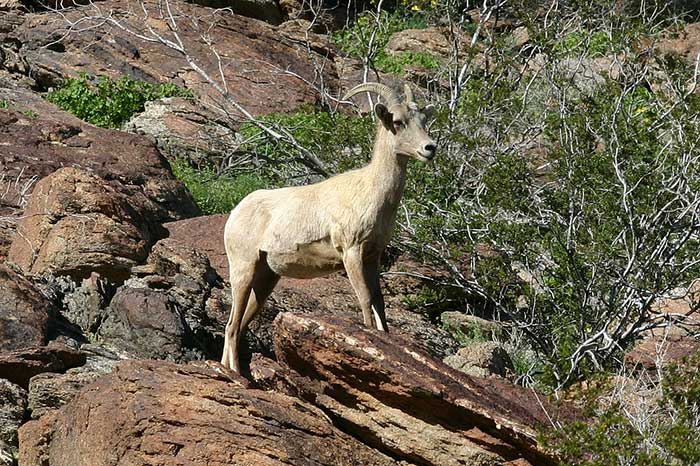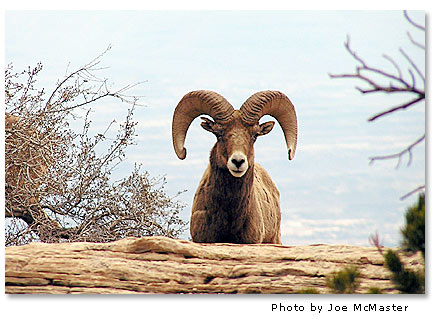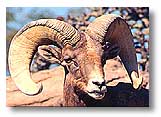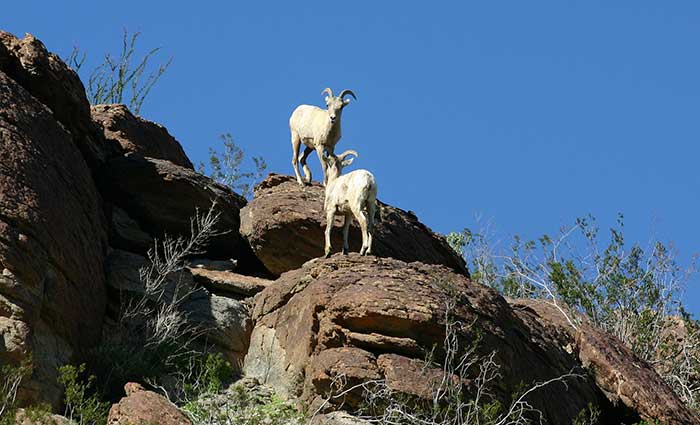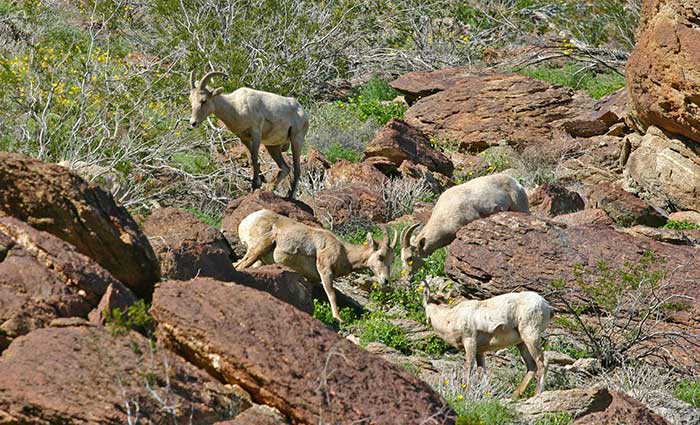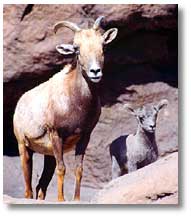 |
Canku Ota
|
 |
|
(Many Paths)
|
||
|
An Online Newsletter
Celebrating Native America
|
||
|
November 2016 - Volume
14 Number 11
|
||
|
|
||
|
Bighorn Sheep
(Ovis canadensis) |
||
|
by DesertUSA.com
|
||
The bighorn's body is compact and muscular; the muzzle, narrow and pointed; the ears, short and pointed; the tail, very short. The fur is deerlike and usually a shade of brown with whitish rump patches. The fur is smooth and composed of an outer coat of brittle guard hairs and short, gray, crimped fleece underfur. The summer coat is a rich, glossy brown but it becomes quite faded by late winter. The male sheep is called a ram and can be recognized by his massive brown horns. The horns curl back over the ears, down, and up past the cheeks. By the time a ram reaches seven or eight years of age, he can have a set of horns with a full curl and a spread of up to 33 inches. Ewes, the females, are smaller than the rams and have shorter, smaller horns that never exceed half a curl. The desert subspecies, Ovis canadensis nelsoni, is somewhat smaller and has flatter, wider-spreading horns. Bighorn Geography – Range
Bighorn Sheep - Curious Facts
Related Species Comparisons
Vocalization
Eyes Tail Ears Nose
Feet Behavior
Males do not defend territories but rather engage in battles over mating access to a particular female. Age as well as horn size determines male dominance status. Although not as well built for climbing as mountain goats, bighorn sheep zigzag up and down cliff faces with amazing ease. They use ledges only two inches wide for footholds, and bounce from ledge to ledge over spans as wide as 20 feet. They can move over level ground at 30 miles per hour and scramble up mountain slopes at 15 m.p.h. They also swim freely, despite their massive bulk and the weight of their horns. Bighorns are generally active during the day, feeding morning, noon and evening, then lying down to chew their cud. They retire to their bedding areas for the night, which may be used for many years. Desert bighorns utilize two mechanisms for cooling -- perspiring, and also panting, which is a fairly uncommon adaptation for desert animals. When the summer rains finally arrive, they resume the more common behavior of their species.
Habitat Food
When summer temperatures become extreme and water sources dry up completely, desert bighorns rest most of the daylight hours and feed at night. During this season, they rely on certain desert plants for both food and moisture. They use their hooves and horns to remove spines from cacti, then eat the juicy insides. They are fond of the tender shoots of prickly pear and cholla, and the flowers of succulents like agave and squawgrass. Breeding
Rutting season is in the autumn and early winter, and births take place in the Bighorn sheep spring, though mating can last from July to December. Gestation lasts from 150-180 days. One or two lambs are born from late February to May. Within a few weeks of birth, lambs form bands of their own, seeking out their mothers only to suckle occasionally. They are completely weaned by 4-6 months of age. In the desert, only about one-third of the lambs will survive their first summer. A lamb born late in the season stands little chance of survival, since temperatures reach over 100 degrees F in May and often reach 120 F by June. Recent studies of high lamb death rates focus on viruses possibly introduced by domestic livestock, to which the native bighorn have little or no immunity. Female bighorn usually do not breed until their second or third year in the wild. Due to competition, males do not usually mate until they are 7 years old. Most sheep live over ten years, with a maximum of 20 years. Ewes are protective of their young for many months. Yearlings, often abandoned while the ewe is giving birth to her next lamb, may be seen again with the ewe and lamb late in the spring. Bighorn find safety in numbers and are ever watchful for predators such as coyotes and mountain lions. Conservation In March, 1998, the Peninsular bighorn sheep was listed as endangered by the U.S. Fish and Wildlife Service. Today, bighorn still range into Baja California, but their numbers have dwindled to less than three percent of the estimated 1.5 million of the early 1800s. In 1979 bighorn between Mt. San Jacinto and the Mexican border were estimated to number 1,180; in 1996 that number had plummeted to 280 sheep. Recent genetic evidence indicates the Sierra Nevada bighorn is a unique form of bighorn found only in the Sierra Nevada. Sierra Nevada bighorn are rarer than the Florida panther, and rarer than the California condor. They are clearly one of the most endangered mammals of North America. In 1986 these sheep were reintroduced to the Mono Basin from a population further to the south. Now the population in Lee Vining Canyon is the primary hope for the future of Sierra Nevada bighorn. Cautions |
||||||||||||||||||||||||||||||||||||||
|
|
|
||
|
|
||
| Canku Ota is a free Newsletter celebrating Native America, its traditions and accomplishments . We do not provide subscriber or visitor names to anyone. Some articles presented in Canku Ota may contain copyright material. We have received appropriate permissions for republishing any articles. Material appearing here is distributed without profit or monetary gain to those who have expressed an interest. This is in accordance with Title 17 U.S.C. Section 107. | ||
|
Canku Ota is a copyright ©
2000 - 2016 of Vicki Williams Barry and Paul Barry.
|
||
 |
 |
|
|
The "Canku
Ota - A Newsletter Celebrating Native America" web site and
its design is the
|
||
|
Copyright ©
1999 - 2016 of Paul C. Barry.
|
||
|
All Rights Reserved.
|
||
